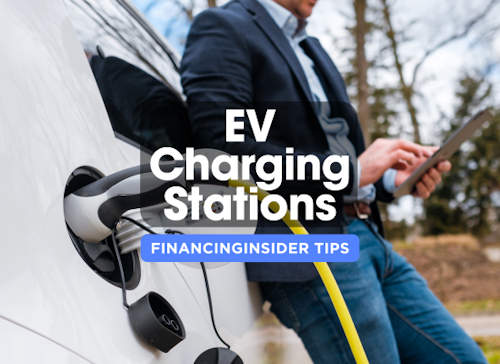As electric vehicles (EVs) continue to grow in popularity, the demand for EV charging stations is rapidly increasing. Entrepreneurs, property owners, and businesses are recognizing the potential in setting up EV charging infrastructure as a profitable venture. However, establishing these stations requires significant investment, from purchasing and installing equipment to ensuring compliance with local regulations. Business loans tailored for EV charging stations provide the financial support needed to jumpstart these projects. In this article, we’ll explore the various types of loans available, the benefits and challenges associated with each, and key insights for securing the best financing for your EV charging station venture.
Hint: Make it to the end for insider tips!
| IncBook: EV Charging Loan Type | Benefits | Challenges | Best for | Interest Rates | Typical Loan Amounts |
|---|---|---|---|---|---|
| Equipment Financing Loan | Covers the cost of purchasing and installing EV charging equipment, allowing for immediate deployment. | Typically requires the equipment to be used as collateral; may have higher interest rates. | Businesses looking to quickly establish charging stations. | 4.0% – 8.0% | $50,000 – $1,000,000 |
| Commercial Real Estate Loan | Finances the purchase of land or property improvements necessary for setting up EV charging stations. | Long approval process; requires significant documentation. | Property owners and businesses expanding their facilities to include EV charging. | 3.5% – 7.5% | $100,000 – $5,000,000 |
| Green Business Loan | Offers favorable terms for projects that contribute to environmental sustainability, including EV charging stations. | May require proof of environmental impact and adherence to green standards. | Businesses committed to sustainability and reducing carbon footprints. | 2.5% – 6.5% | $50,000 – $2,000,000 |
| SBA 504 Loan | Provides long-term, fixed-rate financing for major assets such as land, buildings, and large equipment, including EV chargers. | Complex application process; often requires a down payment. | Small businesses looking to expand operations with EV charging infrastructure. | 3.0% – 5.5% | $125,000 – $5,000,000 |
| Microloan | Offers small-scale financing for businesses needing to install a limited number of charging stations. | Lower loan amounts; may not cover full project costs. | Small businesses or startups entering the EV charging market. | 6.0% – 9.0% | $10,000 – $50,000 |
| Utility-Backed Loan | Financing provided in partnership with local utility companies, often with incentives for installing EV charging stations. | Dependent on utility company partnerships; may include restrictions on equipment and location. | Businesses and property owners in areas with supportive utility companies. | 2.0% – 5.0% | $25,000 – $500,000 |
| Lease-to-Own Financing | Allows businesses to lease EV charging equipment with the option to purchase it at the end of the lease term. | Higher overall costs compared to traditional loans; equipment ownership delayed. | Businesses wanting to minimize upfront costs while still planning for ownership. | 5.0% – 8.5% | $50,000 – $1,000,000 |
| Energy Efficiency Loan | Specifically designed for projects that enhance energy efficiency, such as EV charging stations with integrated solar panels. | May require certification or proof of energy savings. | Businesses aiming to combine EV charging with renewable energy sources. | 3.0% – 6.0% | $50,000 – $2,500,000 |
| Government-Subsidized Loan | Offers subsidized interest rates and favorable terms for EV charging infrastructure as part of clean energy initiatives. | Limited availability; application process may be competitive. | Businesses and municipalities in areas with government incentives for clean energy projects. | 1.5% – 4.0% | $100,000 – $10,000,000 |
Insider Tips
1. Capitalize on Utility Company Partnerships
- Tip: Reach out to local utility companies before applying for a loan. Many utilities offer incentives, rebates, or even co-financing for installing EV charging stations, which can significantly reduce your overall costs. In some cases, utilities may also provide favorable loan terms or grants.
- Why It’s Cool: Utility-backed incentives can be combined with your loan to lower the principal amount you need to borrow, making it easier to qualify for better terms.
2. Utilize Renewable Energy Integration for Better Terms
- Tip: If you plan to integrate renewable energy sources like solar panels into your EV charging station, highlight this in your loan application. Lenders are increasingly prioritizing green projects, and showing a commitment to sustainability can help you secure lower interest rates or even unlock specialized green loans.
- Why It’s Cool: Combining EV charging with renewable energy not only enhances your project’s environmental impact but also positions you as a leader in sustainable infrastructure, making your application more attractive to lenders.
3. Negotiate Performance-Based Repayment Plans
- Tip: Propose a repayment plan based on the performance of your EV charging station, such as the number of charging sessions or energy dispensed. This approach aligns your repayment obligations with your revenue stream, providing flexibility during the ramp-up phase.
- Why It’s Cool: This type of customized repayment plan can reduce pressure in the early stages of operation, allowing your business to grow without the strain of rigid payment schedules.
4. Leverage State and Federal Grants
- Tip: Before securing a loan, exhaust all available state and federal grants dedicated to EV infrastructure. Many regions offer substantial grants that can cover a significant portion of your project costs, reducing the amount you need to borrow.
- Why It’s Cool: Grants can serve as a down payment or equity in your project, which can improve your loan terms or even reduce the need for collateral.
5. Collaborate with Commercial Real Estate Developers
- Tip: If you’re setting up EV charging stations on commercial properties, partner with real estate developers or property management companies. They may be willing to share costs or even co-sign on loans, particularly if the charging stations add value to their properties.
- Why It’s Cool: This collaboration not only reduces your financial burden but also increases the likelihood of securing prime locations for your charging stations.
6. Explore Revenue-Sharing Models
- Tip: Consider entering into revenue-sharing agreements with property owners where the EV charging stations are installed. This can make your loan application more appealing to lenders by demonstrating a diversified income stream.
- Why It’s Cool: A revenue-sharing model can lower your financial risk and create a stronger case for loan approval, especially if you can show a steady, predictable income from multiple sources.
7. Opt for Lease-to-Own with Future Scalability
- Tip: If you’re unsure about the long-term viability of your EV charging business or expect significant technological advancements, start with a lease-to-own financing option. This allows you to upgrade equipment as technology evolves without being locked into outdated infrastructure.
- Why It’s Cool: Leasing initially gives you flexibility, and the option to own later provides security. Plus, lenders may offer more favorable terms if they see you’re committed to scalability and innovation.
8. Seek Local Government Partnerships
- Tip: Engage with local government officials to explore public-private partnerships (PPPs) for EV charging infrastructure. Local governments may provide land, funding, or favorable regulatory conditions that enhance the feasibility of your project.
- Why It’s Cool: Partnering with local governments can open doors to exclusive funding opportunities and political support, which can significantly enhance your project’s success and reduce financial risk.
9. Demonstrate Community Impact
- Tip: Highlight how your EV charging stations will benefit the local community, such as by providing accessible charging in underserved areas or contributing to local sustainability goals. This can strengthen your loan application by showcasing the broader impact of your project.
- Why It’s Cool: Demonstrating community impact can help you secure loans with favorable terms, as lenders are increasingly focused on supporting projects that offer social and environmental benefits.
10. Prepare for Technological Integration
- Tip: Ensure your EV charging stations are equipped to integrate with future technologies, such as smart grid systems or vehicle-to-grid (V2G) technology. Highlighting this capability in your loan application can position your project as future-proof, making it more attractive to forward-thinking lenders.
- Why It’s Cool: Future-proofing your charging stations not only makes them more valuable but also positions you as an innovator, which can help you secure better financing options.
Additional References
U.S. Department of Energy – Electric Vehicle Charging Infrastructure
- URL: https://www.energy.gov/eere/electricvehicles/electric-vehicle-charging-infrastructure
- Description: The U.S. Department of Energy provides comprehensive resources on EV charging infrastructure, including funding opportunities, incentives, and technical guidelines. This is a valuable resource for businesses looking to set up EV charging stations and explore financing options.
California Energy Commission – Electric Vehicle Charging Station Financing
- URL: https://www.energy.ca.gov/programs-and-topics/programs/clean-transportation-program
- Description: The California Energy Commission’s Clean Transportation Program offers grants, loans, and incentives specifically for EV charging infrastructure. This resource is particularly useful for businesses in California seeking to tap into state-level funding and support.
Alternative Fuels Data Center – Laws and Incentives
- URL: https://afdc.energy.gov/laws
- Description: Managed by the U.S. Department of Energy, this site provides a searchable database of federal and state laws, regulations, and incentives related to alternative fuels and vehicles, including EV charging infrastructure. It’s an essential tool for finding applicable grants and loan programs.
European Commission – Sustainable and Smart Mobility Strategy
- URL: https://ec.europa.eu/transport/themes/mobilitystrategy_en
- Description: The European Commission’s mobility strategy includes initiatives for expanding EV charging infrastructure across Europe. This site offers insights into EU funding opportunities, policy guidelines, and the latest developments in smart mobility.
EV Charging Financial Incentives and Grants (UK)
- URL: https://www.gov.uk/government/collections/government-grants-for-low-emission-vehicles
- Description: The UK government provides a range of financial incentives and grants for businesses and organizations to install EV charging stations. This page details the available funding schemes, eligibility criteria, and application processes, making it a crucial resource for UK-based businesses.



